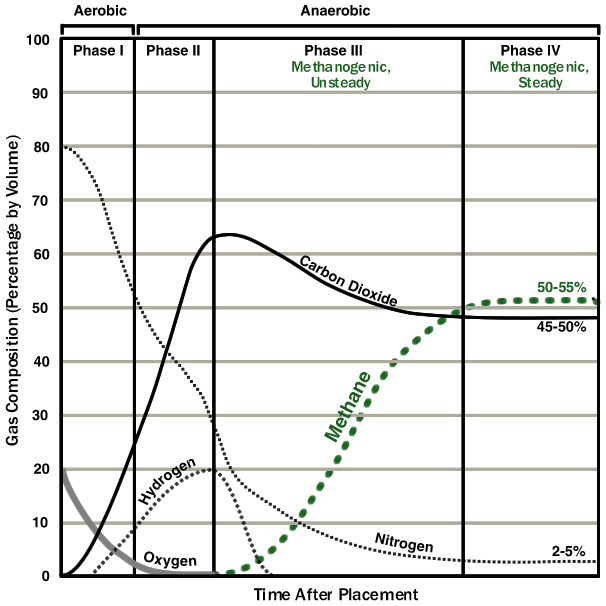Landfill/Remediation
Landfill and Remediation
Landfill gas is a by-product of decomposing landfill waste. At high concentrations, landfill gases can release excessive greenhouse gases, cause undesirable odours and create explosive hazards. Immediate health risks to nearby residents and workers include:
- Dizziness
- Headache
- Confusion
- Asphyxiation due to oxygen displacement
Monitoring landfill gases is a process that continues long after a landfill site has been closed. The process can help monitor what is happening below the surface, improve waste management efficiency and regulatory compliance.
Which Gases Are Produced from Landfill Waste

Throughout a landfill’s lifecycle, gas content and gas concentrations can vary. Consisting predominantly of methane and carbon dioxide, the following gases can also be present at different stages:
- Oxygen
- Nitrogen
- Carbon dioxide
- Hydrogen
- Carbon Monoxide
- Non-methane organic compounds
- Ammonia
Gas content changes throughout the lifecycle of a typical landfill with the different phases is demonstrated in the graph below.
How Landfill Gas Can Impact Our Environment
Migration is a process in which gases can move from one site to another due to factors such as pressure differences in the soil and cavities, as well as permeability. When migration occurs, escaping gases can present a hazard to a wider area outside of the landfill site. Landfill gas monitoring equipment, such as the IECEx Certified Geotech GA5000 Portable Landfill and Contaminated Land Gas Analyser, can provide users with important data on gas conditions at landfills. These instrumentation are ideal for perimeter monitoring, field management, as well as site investigations. The data logged can assist users in meeting regulatory and compliance requirements. The Geotech GA 5000 is one of the instruments mentioned for Category 1 usage according to the landfill gas fugitive emissions monitoring guideline by EPA Victoria. Category 1 gas analysers are specifically designed for the purpose of monitoring landfill gas, whereas, Category 2 gas analysers are low-concentration methane detectors such as the Huberg Laser One.
Throughout recent history, there have been numerous incidents related to the migration of landfill gases. One of the most prominent is the Cranbourne gas leak which occurred in 2008. During the incident, methane gas leaked from a closed site in Cranbourne, Victoria with the gases then migrating into a nearby housing estate. As a result, methane became built up within homes and required residents to evacuate. Landfill gas management assists in helping to manage these risks before they become an issue.
The Benefits of Landfill Gas Monitoring
The success of landfill gas management programs can be aided by monitoring the gases present at each landfill site, improving outcomes during operation as well as in the years after the operation has ceased. There are three main benefits of measuring and recording the gases produced by landfill waste:
- The health of the landfill - measuring concentrations with landfill gas monitoring equipment allow users to monitor the state of decomposition, as well as the health of the gas-generating bacteria. This can prevent subsurface fires and keep the decomposition stable. Continuous monitors such as the GasClam2 Ground Gas Monitor can provide users with long-term unattended measurements and keep users up to date on the health of the landfill.
- Efficiency - by understanding the decomposition of waste, managers can reduce inefficient steps in waste management. This can improve efficiency and focus on proactive action that will make a difference in mitigating risks.
- Regulatory compliance - in Australia, landfills are regulated by each state’s environmental protection authority (EPA) bodies. The main objectives of each state’s regulations are to manage potential hazards, adverse environmental impacts and potential loss of amenities from landfill gas, dust and odour during landfill operation and post closure3. Links to information on landfill management are available from each state’s EPA below.
State EPA Landfill Guidance
- Environmental Protection Authority Victoria | Landfill Guidance
- NSW Environment Protection Authority | Solid Waste Landfill Guidelines
- EPA, South Australia | Environmental Management of Landfill Facilities
- QLD Department of Environment and Science | Landfill Siting, Design, Operation And Rehabilitation
- EPA NT
- EPA Tasmania
Product Range:
- Asbestos
- Beverage Industry
- Construction
- Defence
- Environmental
- Grain & Fumigation
- Groundwater
- HAZMAT
- HVAC
- Indoor Air Quality
- Infrastructure
- Laboratories/Universities
- Landfill/Remediation
- Manufacturing
- Marine
- Mining/Minerals
- Oil and Gas
- Pharmaceutical
- Power Station
- Refineries
- Soil Sampling
- Telecommunication
- Water Treatment
- Asbestos
- Beverage Industry
- Construction
- Defence
- Environmental
- Grain & Fumigation
- Groundwater
- HAZMAT
- HVAC
- Indoor Air Quality
- Infrastructure
- Laboratories/Universities
- Landfill/Remediation
- Manufacturing
- Marine
- Mining/Minerals
- Oil and Gas
- Pharmaceutical
- Power Station
- Refineries
- Soil Sampling
- Telecommunication
- Water Treatment
